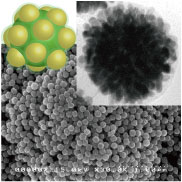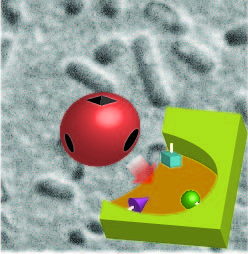RESEARCH
| PRESS RELEASE | |||
|---|---|---|---|
| Preparation of 1-3 dimensional nanoarchitectures | |||
|---|---|---|---|
 One-dimensional |
 Two-dimensional |
 Three-dimensional |
 Three-dimensional |
| Application of nanoarchitectures | |
|---|---|
 |
NanofilmNew strategies that involve a combination of nanomaterials and nanofabrication techniques have been developed in the field of electronics. We developed a green electroless plating technique through a self-assembling between metal nanoparticles (MNPs) and a nontoxic binder. This technique allows a uniform surface coating and thickness reflected by the diameter of AuNPs on the micrometer-sized structures, and enables saving resources and reduction in emissions to the environment. Chem. Commun. 2003, 1038-1039 J. Electrochem. Soc. 160, H630-H635 (2013) Anal. Chem. 86, 4977-4981 (2014) ChemNanoMat 5, 581-585 (2019) |
 |
NanogapThe detection of DNA hybridization is important in the diagnosis of genetic diseases, DNA mapping, and forensic identification. We have developed a nano-gapped electrode by using a molecular electronic technology. The nano-gapped electrode leads us to detect very small electrical signal without labels. We have succeeded in observing the hybridization directly, focusing on the electrical properties of DNA. Nano Lett. 3, 1391-1394 (2003) J. Am. Chem. Soc. 127, 3280-3281 (2005) Anal. Chem. 80, 8071-8075 (2008) J. Am. Chem. Soc. 135, 5238-5241 (2013) Chem. Commun. 53, 5212-5215 (2017) |
 |
NanoantennaPathogenic bacteria, cause widespread hospital-acquired infections and food poisoning, are a major public health problem worldwide. Since nanobioscience is one of the major areas of scientific progress, it should create important advances that benefit human health. We have developed a simple manipulation of gold nanoparticles that creates a structure-dependent nanometer-scale antenna on the surface of bacteria. Our studies illuminate the concept of the "effective use of light" based on the absorption and emission of light by antennas. Chem. Commun. 50, 6252-6255 (2014) Chem. Commun. 50, 11887-11890 (2014) Anal. Chem. 87, 4042-4046 (2015) Anal. Chem. 90, 4098-4103 (2018) |
 |
Molecular imprintingWe have found a new way to circumvent these problems of standard molecularly imprinted polymer (MIP) synthetic procedures. The overoxidized polypyrrole (PPy) indicates unique and attractive features for molecular recognition. We have succeeded in sensing a variety of biomolecules (amino acids, ATP, chole acids, peptides, viruses and microorganisms) as the overoxidized PPy used for the detection platform. Anal. Chem. 74, 4184-4190 (2002) J. Electrochem. Soc. 152, H129-123 (2005) Anal. Chem. 85, 4925-4929 (2013) Anal. Chem. 89, 4680-4684 (2017) Chem. Commun. 53, 3890-3893 (2017) |
 |
Bacterial platformWe have developed successfully an immobilization of living bacteria into the conducting polymers such as polypyrrole (PPy) and poly(3,4-ethylenedioxythiophene) (PEDOT). The bacteria-doped conducting polymer films is useful for bioanalysis, since it is possible for us to observe a proliferative process and various metabolism of bacterium by electrochemical and microscopic measurements. By efficiently using functions of bacteria themselves, we have considered the applications of platform to a various field such as sensing, creation of energy, and production of useful substances. Anal. Chem. 87, 4047-4052 (2015) Anal. Chem. 87, 8416-8423 (2015) Anal. Chem. 90, 10641-11168 (2018) Anal. Chem. 90, 10641-11168 (2019) |




